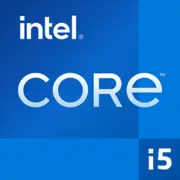Intel Core i5-12600T

Intel Core i5-12600T: Hybrid Efficiency for Everyday Tasks and Beyond
March 2025
The Intel Core i5-12600T processor, introduced in the Alder Lake lineup, remains a relevant solution for users seeking a balance between performance and energy efficiency. Despite the emergence of newer generations, this model retains its position thanks to its unique hybrid architecture and low TDP. In this article, we will explore who this CPU is suitable for, how to integrate it properly into a system, and what to pay attention to during assembly.
1. Key Features: Hybrid Architecture and Efficiency
Alder Lake Architecture and Intel 7 Process Technology
The Core i5-12600T is built on the Alder Lake hybrid architecture, which combines Performance cores (P-cores) and Efficient cores (E-cores). It features:
- 4 P-cores with Hyper-Threading support (8 threads) for resource-intensive tasks;
- 2 E-cores (4 threads) for background processes.
The Intel 7 process technology (10 nm Enhanced SuperFin) provides high energy efficiency. The base frequency of the P-cores is 2.1 GHz, but in turbo mode, they boost up to 4.6 GHz, compensating for the low base frequency.
Performance and Cache
- Geekbench 6: 2178 (Single-Core), 7774 (Multi-Core). These results are comparable to the Ryzen 5 7600 in multi-threaded tasks but are inferior in single-thread performance.
- 18 MB L3 cache speeds up data processing in games and applications.
Key Features
- Intel Thread Director: Optimizes task distribution between P-cores and E-cores.
- PCIe 5.0 support: Allows the use of SSDs with bandwidth up to 14 GB/s.
- Intel UHD Graphics 770: Integrated graphics for basic tasks and 4K video decoding.
2. Compatible Motherboards: Choosing for LGA 1700
The processor uses the LGA 1700 socket, compatible with chipsets:
- H610: Budget option without overclocking and PCIe 5.0 (suitable for office PCs).
- B660/H670: A good middle ground with PCIe 5.0 and DDR5 support (e.g., ASUS Prime B660-Plus, $120–$150).
- Z690/Z790: For enthusiasts with overclocking capabilities (MSI Pro Z790-A WiFi, $220–$300).
Tip: There’s no need to choose top-end Z chipsets for the i5-12600T—a B660 will suffice. If you plan to upgrade to a Core i7/i9, opt for boards with a robust VRM (e.g., Gigabyte Z790 UD AC).
3. Memory Support: DDR4 vs DDR5
The processor supports both types of memory but not simultaneously:
- DDR4-3200: Budget option (16 GB Kingston Fury Beast — $50).
- DDR5-4800+: Higher performance in games and professional applications (16 GB Corsair Vengeance DDR5-5200 — $80).
Practical Example: In Adobe Premiere tests, the difference between DDR4 and DDR5 was 12% in rendering speed. For everyday tasks, DDR4 is sufficient, but DDR5 is justified in the long term.
4. Power Supply Units: Minimum 450W
Despite a TDP of 35W, when combined with a discrete graphics card (e.g., RTX 3060), system consumption can reach 250–300W. Recommended PSUs:
- 450–550W with 80 Plus Bronze certification (Corsair CX550 — $65).
- For systems with high-end GPUs (RTX 4070) — 650W (Seasonic Focus GX-650 — $100).
Important: Don’t skimp on the power supply—low-quality models can lead to system instability.
5. Pros and Cons of the i5-12600T
Advantages:
- Low power consumption (ideal for mini PCs and office systems).
- Good multi-threaded performance for video editing and 3D modeling.
- Integrated graphics for basic gaming (CS:GO — 60 FPS on low settings).
Disadvantages:
- Without a discrete graphics card, it’s not suitable for modern AAA games.
- Heats up under load (up to 85°C with the stock cooler).
- DDR5 increases the overall cost of the build.
6. Use Cases: Where the Potential Shines
- Office and Multimedia: Fast operation with browsers, office applications, and streaming video.
- Home Theater: 4K HDR support via HDMI 2.1.
- Light Gaming: In conjunction with an RTX 3060 GPU — Cyberpunk 2077 at medium settings (1080p, 60 FPS).
- Freelancing: Photo editing in Photoshop, video editing in DaVinci Resolve.
Limitations: Don’t choose this processor for heavy rendering or 4K streaming—better options are i7 or Ryzen 7.
7. Comparison with Competitors
- AMD Ryzen 5 7600: Higher single-thread performance (+15% in Geekbench 6), but a TDP of 65W and more expensive ($280).
- Intel Core i5-13400T: New generation, but performance gain is only 8–10% for $270.
- Apple M2 (for comparison): Best energy efficiency, but limited compatibility with Windows software.
Conclusion: The i5-12600T excels in price ($200–$220) and versatility for hybrid tasks.
8. Practical Assembly Tips
1. Cooling: The stock cooler is adequate, but for quieter operation, choose a tower cooler (DeepCool AK400 — $35).
2. Case: Mini-ITX for compactness (Cooler Master NR200) or Mid-Tower with good airflow.
3. Storage: PCIe 4.0 SSD (Samsung 980 Pro 1TB — $90) for maximum speed.
4. BIOS Optimization: Enable the XMP profile for RAM and update the microcode for stability.
Example build for $700 (excluding GPU):
- CPU: i5-12600T ($210)
- Motherboard: ASUS Prime B660M-A ($130)
- Memory: 16 GB DDR4-3200 ($50)
- SSD: 1 TB NVMe ($90)
- PSU: Corsair CX550 ($65)
- Case: Fractal Design Focus G ($60)
9. Final Conclusion: Who is the i5-12600T Suitable For?
This processor is an ideal choice for:
- Office PCs requiring quiet operation and energy savings.
- Home media centers, where 4K support is important.
- Academic projects and freelancing (design, editing).
- Budget gaming systems with a discrete graphics card.
Why choose it? The combination of low power consumption, sufficient performance, and affordable price makes the i5-12600T one of the best in its category in 2025. If you don’t need maximum FPS in games or extreme multitasking, this CPU will provide a reliable foundation for work and entertainment.
Basic
CPU Specifications
Memory Specifications
GPU Specifications
Miscellaneous
Benchmarks
Compared to Other CPU
Share in social media
Or Link To Us
<a href="https://cputronic.com/cpu/intel-core-i5-12600t" target="_blank">Intel Core i5-12600T</a>